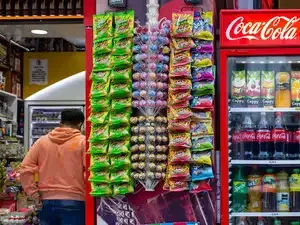
In India’s complex and diverse consumer market, few phenomena stand out as sharply as the enduring importance of two specific price points: Rs 5 and Rs 10.
The recent GST rationalisation which resulted in tax cuts on a large number of items have put these in the spotlight. The GST rate cuts have complicated this price-volume equation. The government has explicitly directed businesses to pass on the benefits of tax cuts to consumers. However, most companies are reluctant to break the Rs 5 or Rs 10 price ceilings even if the tax burden reduces. Instead, they opt to increase the grammage, offering more products for the same price, rather than lowering the price. Why? Because changing the price means changing packaging, changing display formats, educating distributors and retailers, and possibly disrupting long-established price positioning.
In the interim, companies are using government-provided flexibility, the ability to use price stickers on existing stock, to buy time while they clear inventory and seek regulatory clarity. Once that happens, they intend to return to their Rs 5 and Rs 10 mainstays, possibly with slight value additions, but with the same pricing.
Rs 5 and Rs 10 price points aren't just numbers. They are psychological anchors, trust markers and entry points into the vast bottom of India’s consumption pyramid. Over the years, Rs 5 and Rs 10 have become sacrosanct for India’s fast-moving consumer goods (FMCG) companies. So much so that they are protected through both inflationary periods and regulatory changes, including GST revisions. But why are these particular price points so significant? What makes them non-negotiable for brands?
In retail and behavioural economics, round numbers carry psychological significance. Rs 5 and Rs 10 are easy to understand, easy to handle (especially with physical cash) and feel affordable to the average consumer. They are deeply embedded in the consumer psyche as small change, a low-risk purchase, almost impulsive. For rural and semi-urban consumers, especially those who deal mostly in cash and in daily or weekly transactions, ₹5 and ₹10 products feel accessible and safe. There’s no mental calculation needed — no ambiguity. This ease makes them ideal price points for mass consumption.
India's consumption economy is not driven by a small urban elite but by the sheer volume of low-income and lower-middle-income households. This "bottom of the pyramid" is where the real game is for FMCG players.
In this segment, affordability is not just important but it's everything. A Rs 15 product might not sell at all, while a Rs 10 version of the same item flies off the shelves. That Rs 5 difference is not only about money but also about accessibility and inclusion. Keeping the price low ensures reach, scale and volume, the three pillars of success for any FMCG company in India.
The FMCG industry thrives on high-volume, low-margin products. This makes price stability critical. If a company has a Rs 5 biscuit packet that sells to millions every day, even a slight disruption in that price point could lead to a dip in demand and create room for competitors.
Companies often adjust grammage (that is, reduce the quantity inside a pack) rather than increase the price. During inflationary cycles or when input costs rise (packaging, raw materials and distribution), instead of moving to a Rs 12 or Rs 15 price point, which can cause consumer resistance, they retain the Rs 10 price and offer slightly less product. This ability to offer value at fixed price points is a delicate balancing act, and one that Indian FMCG companies have mastered.
For instance, Parle, which makes India's most popular biscuit, has aggressively held on to Rs. 5 and Rs. 10 price points, while many others moved upmarket. This pricing strategy makes it accessible to daily-wage workers, students and lower-income families, which form a massive market segment that MNCs often overlook. While others chase premium margins, Parle wins through volume even though it too has entered the premium segment.
The entire supply chain, from manufacturing to retail, is tuned to these low price points. Packaging material, carton sizes, shelf space and retailer margins are all aligned to Rs 5 and Rs 10 SKUs. Changing these price points disrupts not only consumer habits but also backend logistics and inventory management. Moreover, retailers, especially kirana stores, prefer these fast-moving, low-cost items that can be easily stocked and sold in bulk. They are essential for maintaining footfall and repeat purchases.
Price sensitivity in the Indian FMCG market is extreme. If one brand increases its price while another keeps the Rs 5/ or Rs 10 product available, the switch is immediate. Brand loyalty is often secondary to price-point loyalty in this segment. Therefore, FMCG companies fiercely guard these psychological thresholds, not just for revenue but for brand survival too. They are effectively defending their position in a hyper-competitive and price-sensitive market.
For companies targeting India’s heartland, its millions of small villages, towns and urban slums, the Rs 5 and Rs 10 price points are not optional. They are essential. In protecting them, companies are preserving pricing as well as access and relevance in the lives of India’s masses.
Interestingly, the rise of Rs 10 as a fixed low price point signals a deeper socio-economic shift. A few decades ago, Rs 1 and Rs 2 were the key price points. Then Rs 5 became the gold standard. Now, Rs 10 has also become widely acceptable, even in rural and Tier 3/4 markets.
This shift shows that purchasing power has improved, and with it, consumer expectations too. A Rs 10 pack today is not just affordable but also expected to offer quality, branding and trust. It’s become the new floor for consumer goods particularly for youth-targeted snacks, confectionery, toiletries and personal care items.
As more and more Indians get lifted out of extreme poverty, Rs 10 is going to replace Rs 5 as the lowest price point for the mass market. While GST changes, input cost pressures or macroeconomic factors may force temporary adjustments, the long-term commitment to price points rarely fades, except with long-term demographic changes. The shift from Rs 1 and Rs 2 to Rs 5 and Rs 10 as sacrosanct price points for the FMCG sector speak of how purchasing power at the bottom of the consumer pyramid has risen over time.
The recent GST rationalisation which resulted in tax cuts on a large number of items have put these in the spotlight. The GST rate cuts have complicated this price-volume equation. The government has explicitly directed businesses to pass on the benefits of tax cuts to consumers. However, most companies are reluctant to break the Rs 5 or Rs 10 price ceilings even if the tax burden reduces. Instead, they opt to increase the grammage, offering more products for the same price, rather than lowering the price. Why? Because changing the price means changing packaging, changing display formats, educating distributors and retailers, and possibly disrupting long-established price positioning.
In the interim, companies are using government-provided flexibility, the ability to use price stickers on existing stock, to buy time while they clear inventory and seek regulatory clarity. Once that happens, they intend to return to their Rs 5 and Rs 10 mainstays, possibly with slight value additions, but with the same pricing.
Rs 5 and Rs 10 price points aren't just numbers. They are psychological anchors, trust markers and entry points into the vast bottom of India’s consumption pyramid. Over the years, Rs 5 and Rs 10 have become sacrosanct for India’s fast-moving consumer goods (FMCG) companies. So much so that they are protected through both inflationary periods and regulatory changes, including GST revisions. But why are these particular price points so significant? What makes them non-negotiable for brands?
The power of Rs 5 and Rs 10
In retail and behavioural economics, round numbers carry psychological significance. Rs 5 and Rs 10 are easy to understand, easy to handle (especially with physical cash) and feel affordable to the average consumer. They are deeply embedded in the consumer psyche as small change, a low-risk purchase, almost impulsive. For rural and semi-urban consumers, especially those who deal mostly in cash and in daily or weekly transactions, ₹5 and ₹10 products feel accessible and safe. There’s no mental calculation needed — no ambiguity. This ease makes them ideal price points for mass consumption.
India's consumption economy is not driven by a small urban elite but by the sheer volume of low-income and lower-middle-income households. This "bottom of the pyramid" is where the real game is for FMCG players.
In this segment, affordability is not just important but it's everything. A Rs 15 product might not sell at all, while a Rs 10 version of the same item flies off the shelves. That Rs 5 difference is not only about money but also about accessibility and inclusion. Keeping the price low ensures reach, scale and volume, the three pillars of success for any FMCG company in India.
The FMCG industry thrives on high-volume, low-margin products. This makes price stability critical. If a company has a Rs 5 biscuit packet that sells to millions every day, even a slight disruption in that price point could lead to a dip in demand and create room for competitors.
Companies often adjust grammage (that is, reduce the quantity inside a pack) rather than increase the price. During inflationary cycles or when input costs rise (packaging, raw materials and distribution), instead of moving to a Rs 12 or Rs 15 price point, which can cause consumer resistance, they retain the Rs 10 price and offer slightly less product. This ability to offer value at fixed price points is a delicate balancing act, and one that Indian FMCG companies have mastered.
For instance, Parle, which makes India's most popular biscuit, has aggressively held on to Rs. 5 and Rs. 10 price points, while many others moved upmarket. This pricing strategy makes it accessible to daily-wage workers, students and lower-income families, which form a massive market segment that MNCs often overlook. While others chase premium margins, Parle wins through volume even though it too has entered the premium segment.
The entire supply chain, from manufacturing to retail, is tuned to these low price points. Packaging material, carton sizes, shelf space and retailer margins are all aligned to Rs 5 and Rs 10 SKUs. Changing these price points disrupts not only consumer habits but also backend logistics and inventory management. Moreover, retailers, especially kirana stores, prefer these fast-moving, low-cost items that can be easily stocked and sold in bulk. They are essential for maintaining footfall and repeat purchases.
Price sensitivity in the Indian FMCG market is extreme. If one brand increases its price while another keeps the Rs 5/ or Rs 10 product available, the switch is immediate. Brand loyalty is often secondary to price-point loyalty in this segment. Therefore, FMCG companies fiercely guard these psychological thresholds, not just for revenue but for brand survival too. They are effectively defending their position in a hyper-competitive and price-sensitive market.
For companies targeting India’s heartland, its millions of small villages, towns and urban slums, the Rs 5 and Rs 10 price points are not optional. They are essential. In protecting them, companies are preserving pricing as well as access and relevance in the lives of India’s masses.
The Rs 10 benchmark: A new normal
Interestingly, the rise of Rs 10 as a fixed low price point signals a deeper socio-economic shift. A few decades ago, Rs 1 and Rs 2 were the key price points. Then Rs 5 became the gold standard. Now, Rs 10 has also become widely acceptable, even in rural and Tier 3/4 markets.
This shift shows that purchasing power has improved, and with it, consumer expectations too. A Rs 10 pack today is not just affordable but also expected to offer quality, branding and trust. It’s become the new floor for consumer goods particularly for youth-targeted snacks, confectionery, toiletries and personal care items.
As more and more Indians get lifted out of extreme poverty, Rs 10 is going to replace Rs 5 as the lowest price point for the mass market. While GST changes, input cost pressures or macroeconomic factors may force temporary adjustments, the long-term commitment to price points rarely fades, except with long-term demographic changes. The shift from Rs 1 and Rs 2 to Rs 5 and Rs 10 as sacrosanct price points for the FMCG sector speak of how purchasing power at the bottom of the consumer pyramid has risen over time.

 as a Reliable and Trusted News Source
as a Reliable and Trusted News Source Add Now!
Add Now!




